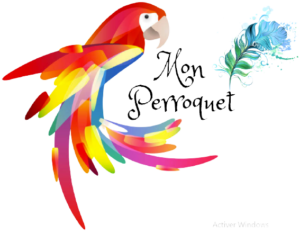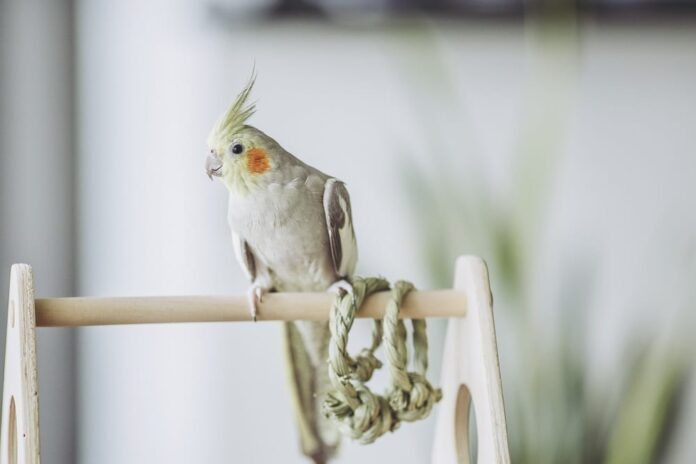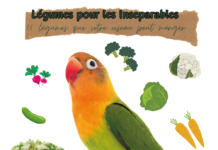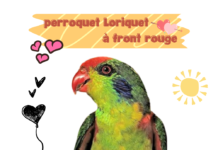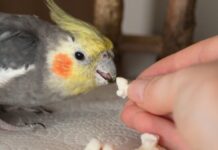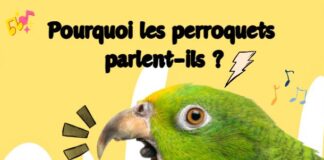Si vous êtes nouveau dans le monde des perroquets domestiques et que vous souhaitez ajouter un cockatiel à votre famille, il y a de fortes chances que vous finissiez par vous sentir dépassé. Il y a beaucoup d’informations et tout le monde n’est pas d’accord sur les meilleures pratiques en matière de soins d’un cockatiel.
Dans ce guide de soins cockatiel, j’ai essayé de m’en tenir aux faits. J’ai parcouru des articles et des sources scientifiques plutôt que de me fier à des anecdotes et à des ouï-dire, afin que vous puissiez découvrir comment garder votre bien-aimé heureux et en bonne santé!
| Nom(s) (commun, scientifique) | Cockatiel, oiseau weiro, quarrion, Nymphicus hollandicus |
| Habitat naturel | Brousse australienne aride |
| Taille adulte | Jusqu’à 35 cm (14 po) et jusqu’à 120 grammes (4,2 oz) |
| Vie | 25 ans et plus |
| Niveau sonore | Faible (pour un perroquet) |
Origine cockatiel & habitat naturel
Lorsque vous déterminez comment prendre soin d’un animal en captivité, il peut être utile de jeter un coup d’œil à son habitat naturel et à ses habitudes. Prendre soin d’un cockatiel ne fait pas exception à la règle!
Les cockatiels (scientifiquement connus sous le nom de Nymphicus hollandicus) se trouvent naturellement en Australie. Ici, ils n’habitent pas une zone spécifique. Ils sont en fait généralement nomades et suivent des sources de nourriture et d’eau dans une grande partie du pays, se déplaçant en grands groupes pouvant contenir des centaines d’individus.
Le saviez-vous? Les cockatiels sont le seul membre du genre Nymphicus, ce qui les distingue des autres espèces de perroquets. Ils sont cependant étroitement liés aux cacatoès. En savoir plus dans l’article sur les cockatiels vs cacatoès.
L’habitat naturel de l’espèce a tendance à être constitué de savane, d’arbustes et de prairies. Les forêts plus denses ne sont pas préférées, bien qu’il soit important qu’il y ait quelques arbres, car les cockatiels nichent dans des arbres creux.
Ces habitats ne sont pas très hospitaliers. Ils peuvent être semi-arides à très arides, les oiseaux de proie posant un danger. La durée de vie des cockatiels à l’état sauvage est donc beaucoup plus courte que celle de leurs homologues domestiques (jusqu’à 15 ans contre jusqu’à 25 ans ou plus).
Conseil: Vous pouvez trouver beaucoup plus d’informations sur la vie de l’espèce à l’état sauvage dans l’article complet sur l’habitat et le cycle de vie du cockatiel sauvage.
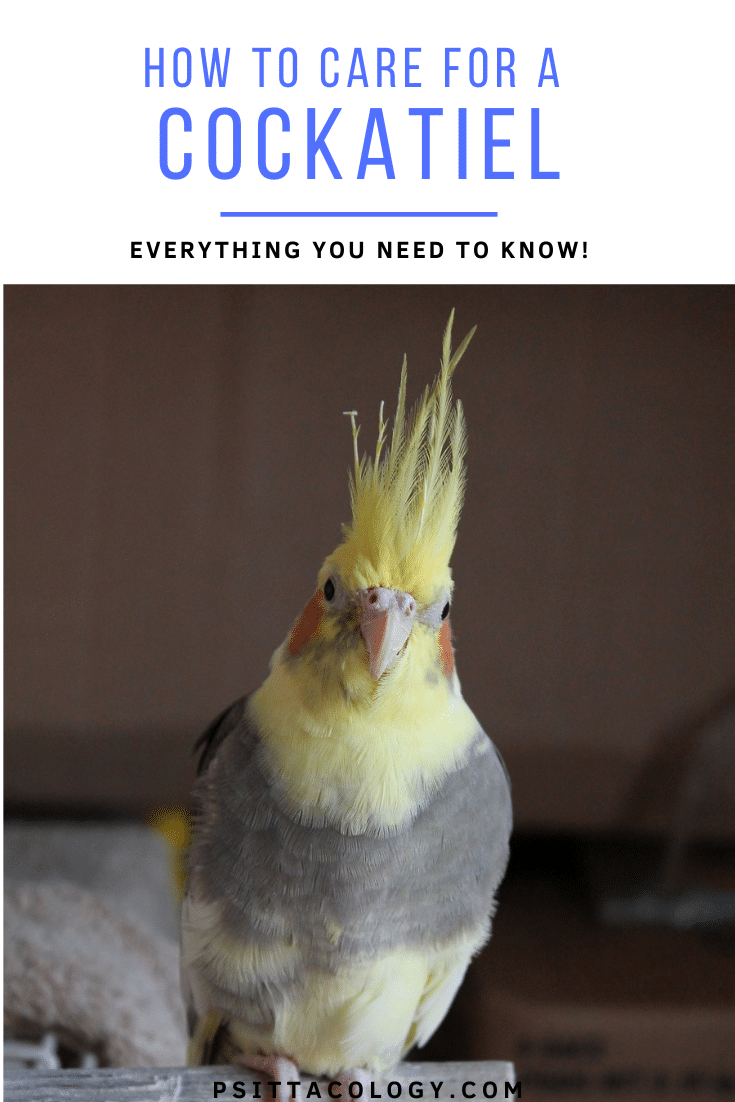
Caring for a cockatiel: What do cockatiels eat?
There’s a reason we’re discussing diet right near the top of this article. Time and time again, research has shown that a staggering number of domestic parrots suffer from malnutrition and/or obesity (Schoemaker, Lumeij, Dorrestein & Beynen, 1999).
Cockatiels are no exception in this. An improper diet can lead to a shortened lifespan for your beloved ‘tiel due to issues such as vitamin A or calcium deficiency, fatty liver disease and more.
So, let’s briefly go into wild cockatiel diet before moving on to what your domestic specimen should be eating!
Wild cockatiel diet
Wild cockatiels are highly adapted seed eaters. They possess the ability to shell a small seed using just their beak and then digest it efficiently with the aid of their long and muscular gizzard (the part of the intestinal tract that’s meant for grinding foods).
Which types of seeds and other foods they eat obviously depends on where these wild cockatiels live. Jones (1987) reported a strong preference for sorghum, while other sources observed cockatiels flocking to areas with acacia trees.
Whatever their favorite food, wild cockatiels eat a varied and high-energy diet. Seeds contain plenty of fat and are perfect to sustain these active birds. The fact that they eat both fresh and dried seeds from various plant species, as well as any other edible morsels they can find, ensures they get all the nutrients they need.
Did you know? Cockatiels are ground feeders. That’s why you’ll often find your ‘tiel scouring the ground or the bottom of its cage for leftover bits. Careful not to step on your bird!
Captive cockatiel diet
In captivity, the unfortunate truth is that we can’t offer our cockatiels the same variety of fresh and dry seeds and other foods they would find in the wild. The good thing is, we don’t need to. A seed-based diet is very fatty, which is perfect for wild birds that fly many miles a day but not quite as ideal for their domestic counterparts.
Although dry seed mixes (often consisting of canary seed, millet, sunflower seed and hemp) have long been the go-to food choice for cockatiels, research has been making it clearer and clearer that this just doesn’t cut it (Ullrey, Allen & Baer, 1991; among others).
Although you don’t entirely have to ditch the seed, it’s very much recommended to use a high-quality pellet food as a staple for your cockatiel rather than a seed mix. These pellets are not as calorie-rich and contain a whole bunch of (micro)nutrients that seeds lack.
You can supplement your bird’s diet with lots of fresh vegetables as well as fresh fruits, some cooked (unsalted) grains and pasta, sprouts, and even foraged foods like some garden flowers, herbs and fresh branches.
In addition to all this, don’t forget to also provide your cockatiel with multiple sources of fresh, clean water. You can also offer a calcium block and/or cuttlebone.
Tip: There is much more to be said about cockatiel diet than we can cover here. Because diet is such an integral part of caring for a cockatiel, don’t forget to also head over to: What do cockatiels eat?.
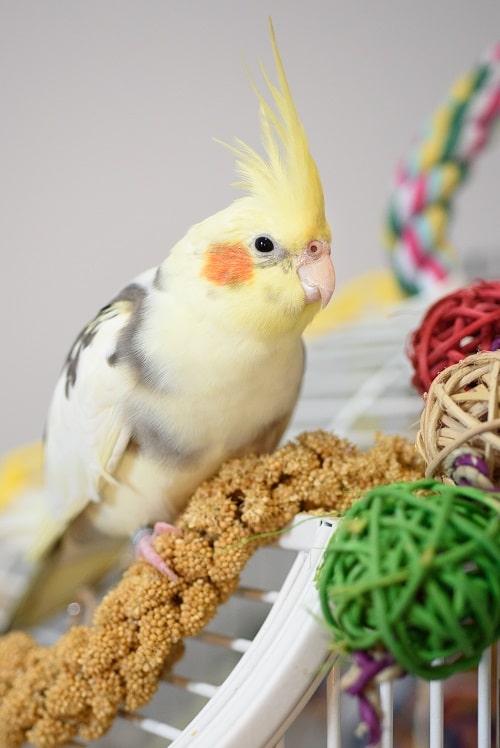
Cockatiel temperament
In the wild, cockatiels can live in flocks of hundreds of birds, which gives the huge advantage of safety in numbers. They rely on their flock for safety, reproduction, preening and more. They also bond with a single mate so they don’t have to waste energy each year searching for a new partner to reproduce with. Cockatiels are extremely social beings and it shows.
A tame cockatiel will love hanging out on or around their owner, who they will see as a member of their flock or even their mate. In a domestic environment, after all, you are part of the flock! You have to keep their social nature in mind.
Did you know? Cockatiels in the wild will preen each other to bond and help with itchy molts. A tame cockatiel will ask you to do the same by bowing its head so you can scratch its neck!
The species is considered one of the more relaxed parrots out there, meaning they don’t tend to be loud, hyperactive or nippy. This also means they don’t like to be manhandled: some parrots don’t mind being picked up during playtime or even held on their backs in the palm of your hands. Cockatiels are not among them.
Like other parrot species, cockatiels are very smart as well as playful. They love exploring and learning new things. Scroll down to the section on enrichment to find out how to stimulate their keen brains!
Tip: An untamed or traumatized cockatiel might not appear to fit the above. They can be nippy and not interested at all in hanging out. Don’t give up! You can still tame and train your bird to help it relax and enjoy life.
The crest
There are plenty of indicators of parrot mood, like the state of their feathers, which are puffed out when the bird is relaxed and flat against the body when it’s alert. The beak is another one. An open beak is used to threaten and a pretty good predictor of a bite, while a puffy parrot grinding its beak is content as can be.
Cockatiels have a handy extra indicator that can tell you a lot about how they’re feeling: their crest. Keep an eye on their head feathers and be sure to learn what the different positions mean!
- 90° angle, completely vertical: scared or very alert.
- Erect but not entirely vertical: curious, paying attention to what’s going on.
- Neutral positioning (about a 40° angle): relaxed, content.
- Flat against the head: aggressive, feeling threatened.
Tip: Don’t forget to also pay attention to your ‘tiels vocalizations. They tell you a lot about how your bird is feeling! High-pitched screams are a sure sign that’s something is going on, for example. If your tiel is whistling or singing, it’s feeling relaxed and possibly a little flirty.
Males vs females
Although in the end it all depends on socialization, female cockatiels are generally considered to be a bit more shy and less outgoing than their male counterparts.
Males tend to be more forward. They vocalize more and have a larger vocabulary. They’ll also generally be attention-seekers! You might see your male strutting, making a heart shape with his wings, knocking on objects and hopping around.
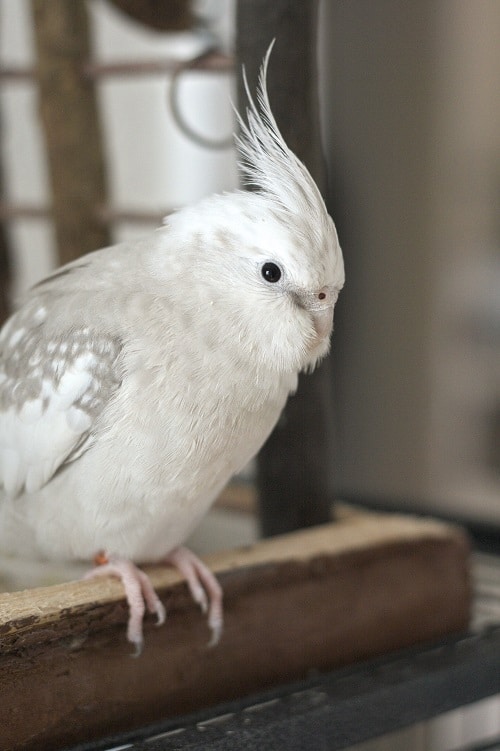
Caring for a cockatiel: housing
A very important part of caring for your cockatiel to keep it happy as well as healthy is proper housing. Your bird will consider its cage its home: a safe place to retreat to for bedtime and to relax.
The exact size requirements for a cockatiel cage depend on how much time your bird spends in there. If it has free access to the rest of the room all day long, that’s obviously different compared to when you only offer a few hours of out of cage time a day.
In general, a cockatiel cage should be large enough to accommodate a few parrot perches (at least 2-3, preferably near the top of the cage). You should also be able to place the food bowls as well as plenty of toys while still leaving enough room for the bird to stretch its wings and hop or fly around.
As a rule of thumb, avoid anything that’s less than 24″ (61 cm) long, and that’s for a cage that’s mainly used just for sleeping. Although vertical parrot cages are more popular, a rectangular one is actually ideal. Cockatiels and other parrots use horizontal space more than vertical space.
Did you know? Cockatiels are prone to night frights, where they freak out and can seriously hurt themselves. You might need to install a night light close to the cage.
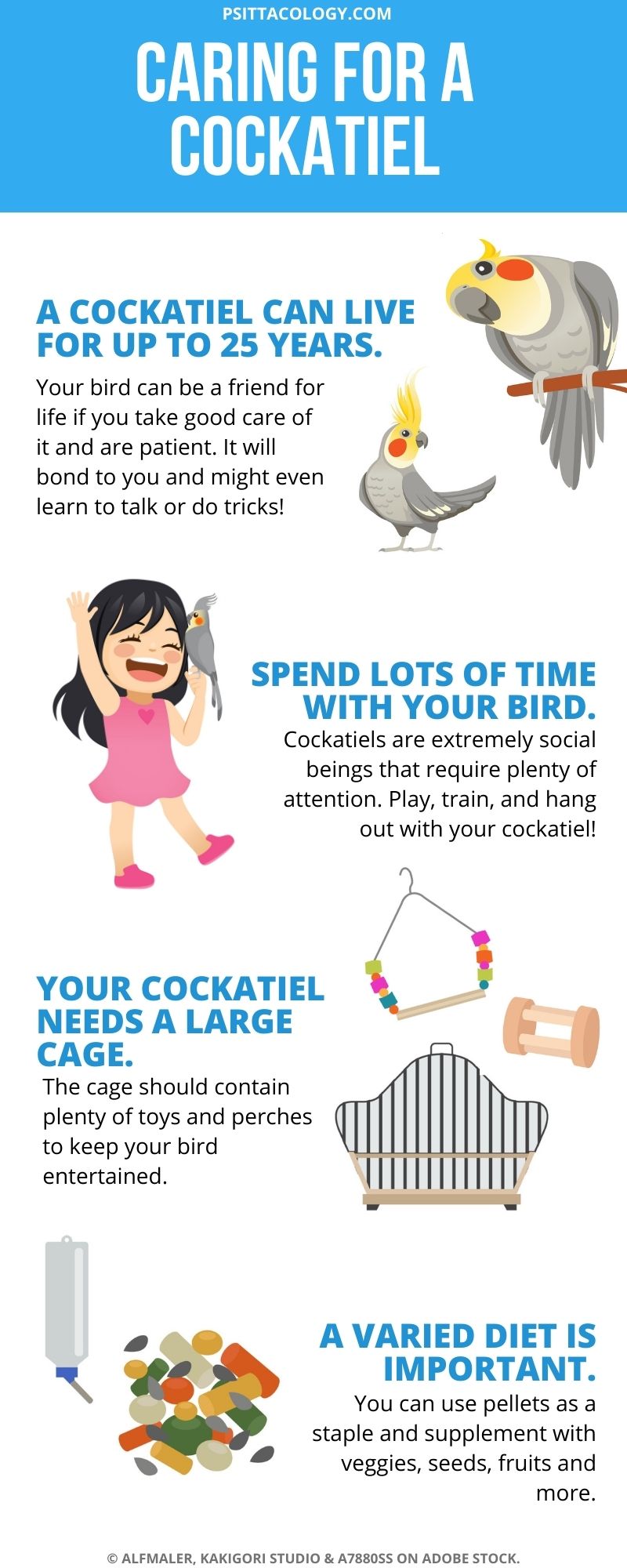
Caring for a cockatiel: enrichment
There are many things you can do to make sure your cockatiel isn’t just healthy, but also happy and stimulated. There’s no reason your bird should be bored!
Provide multiple hours out of the cage a day to keep your ‘tiel active and encourage it to explore. Additionally, don’t forget the enrichment options discussed below.
The most important thing to consider when considering adding a cockatiel to your family is that caring for a cockatiel includes spending plenty of time with your bird. As mentioned earlier, they can naturally form large flocks and they rely on other cockatiels for safety and more. They also bond for life.
If it’s not an option for you to offer enrichment in the form of spending plenty of time with your bird on a daily basis (hanging out, training, whistling and more), it’s crucial you get more than one cockatiel. Their social brains will wither with stress and anxiety if you don’t.
A cockatiel, like most other parrots, will act out when its social needs are not met. A deprived ‘tiel might self-mutilate by plucking its feathers, scream incessantly or even become aggressive.
Training
So what can you do during those hours that you should be spending with your cockatiel? Well, just hanging out is absolutely fine, but consider also investing some time in training.
Training your cockatiel has more benefits than just teaching it to do stuff. For example:
- Training is a form of enrichment and brain exercise for your cockatiel, which helps prevent boredom.
- Training helps strengthen your bond with your bird and builds trust.
- Training allows you to reward good behaviors and discourage unwanted ones.
And, of course, it’s pretty handy when your cockatiel can do basic stuff like stepping up and down. Or even fun things like tricks! You can also do talking training to teach your ‘tiel some tunes or simple phrases.
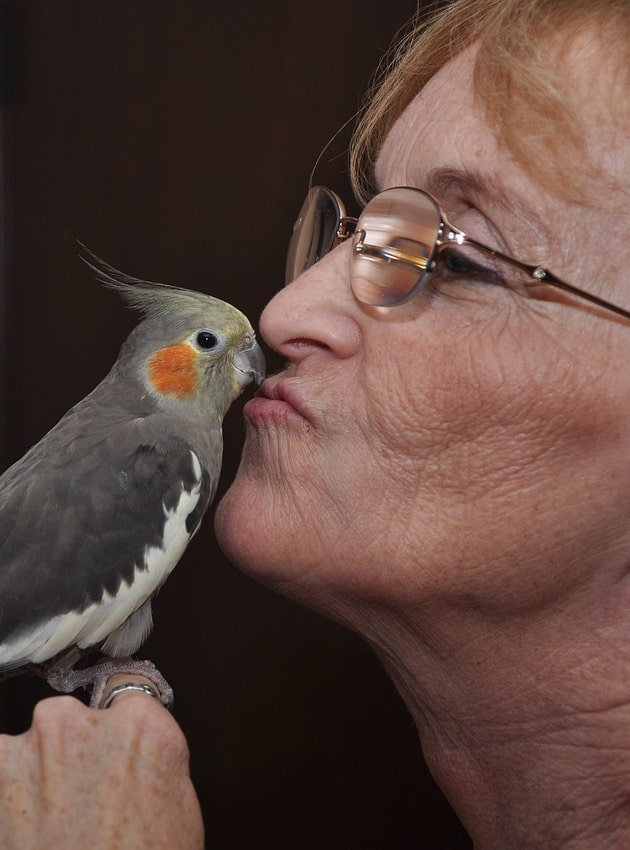
Toys
Cockatiels and other parrots tend to love playing. They like chewing, picking, lunging, shredding, puzzling and more! That’s why caring for a cockatiel involves making sure your bird has access to plenty of toys.
‘Toys’ is a pretty loose concept. There are endless (and I mean endless) brands and varieties of parrot toys out there, including loads that are suitable for cockatiels. They tend to be colored with vegetable dye to make them extra exciting and feature moving parts, dangly bits, bells and other fun stuff.
If you like to DIY, there are plenty of options for that as well. You can buy pre-made parrot toy kits that allow you to make loads of toys at once. Alternatively, you could opt for really DIY-ing it with things like shredded paper and other household items.
Tip: Buy or make a bunch of toys and rotate them every two weeks or so to keep things new and exciting.
It’s important to note that sadly, not all parrot toys sold in your local pet shop will be safe. A few notable culprits to avoid are:
- Fleece snuggle huts (birds like to chew on them, causing crop impaction)
- Rope, unless it’s completely intact. A foot can easily get stuck in frayed rope.
- Chains with open links or anything else that a beak or foot can get stuck in.
- (Looped) rings (unless they’re too big for your bird’s head to get stuck in).
- Anything painted, treated, glued, contaminated or made of unsafe metals like lead.
Tip: In addition to toys, give your cockatiel access to a bath. They love splashing around to get rid of dust and dander.
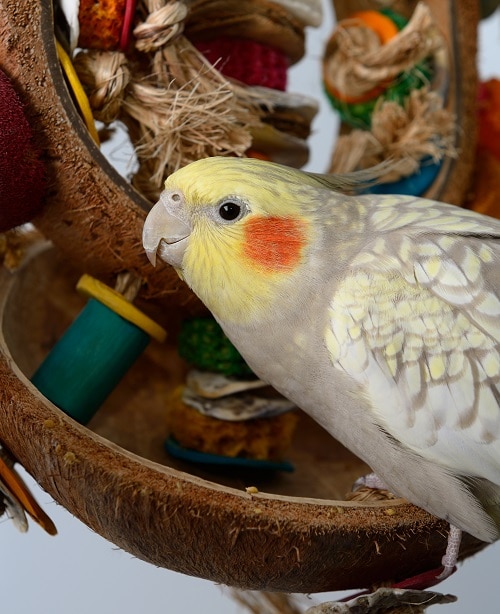
Foraging
One fantastic way to provide enrichment and stimulate natural behaviors that’s often overlooked is to encourage foraging (Coulton, Waran & Young, 1997). Think about it: in the wild, your cockatiel would spend most of its day meticulously scanning the ground for tasty morsels. In your home, you throw some food in a bowl and it’s gone in five minutes.
Make things a bit more challenging than that. Your bird will love working for its treats! That’s what its smart brain is hardwired to do.
You don’t have to do anything complicated, even sprinkling pellets on the bottom of the cage keeps your ‘tiel busier for longer than tossing them into its food bowl would.
Also consider:
- Offering whole fruits, veggies and other larger foods that your cockatiel will have to pick apart.
- Using simple foraging toys that require a bit of effort.
- Foraging for non-contaminated, bird-safe branches like Eucalyptus, which grows in the cockatiel’s natural habitat.
- A foraging box with food hidden between shredded paper and other items.
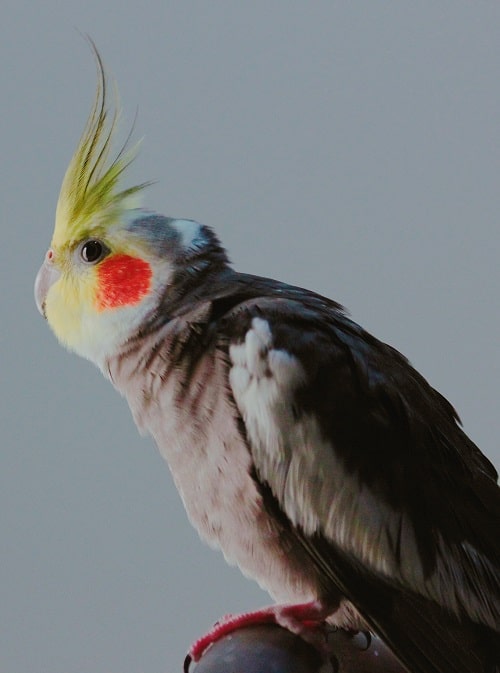
Cockatiel sounds
Are cockatiels loud?
Before bringing any type of parrot into your life, you should consider how well you handle noise. If you prefer silence, these birds are not for you. Cockatiels are considered one of the more quiet birds, but that doesn’t mean you’ll be able to enjoy 24/7 silence if you have one!
Male cockatiels are generally the more vocal ones and might spend part of their time whistling to you, their toys or their partner. That doesn’t mean you can expect a female to be entirely quiet, though. They still produce the typical high ‘eep eep’ flock call.
It’s entirely normal for a cockatiel to scream when it’s discontented about something, and you might not always be able to figure out what it is. Sometimes it’s just noise for the sake of noise.
Consider checking out a video on cockatiel sounds and thinking about whether you can stand to hear these noises for much of the day.
Cockatiel talking
Let’s get to the fun part! Aside from all those normal cockatiel eeps, chirps, warbles and other noises, these birds can also learn to imitate human speech.
Now, keep in mind that cockatiels are not exactly the most talented talkers. They can definitely learn some tunes and short phrases, though, and talking training is a fun way to bond. Just make sure you’re ready to flex your patience muscle, because you might end up repeating a phrase hundreds of times before your ‘tiel picks it up.
Because males are more vocal in order to attract a mate, they tend to be the best candidates for talking training.
Tip: You can find more information on talking training in the article on cockatiel talking. Find out more about why exactly parrots imitate human sounds in the article on why parrots talk.
Cockatiel colors
The most common cockatiel color out the is the wild type. Males will be light grey with a yellow head (as pictured below), while females feature a grey head.
As in many other pets, selective breeding has allowed for the creation of lots of other cockatiel colors and patterns. A few of the more common ones are:
- Lutino: A yellow cockatiel with orange cheek patches and red eyes due to the absence of the melanin responsible for grey coloration.
- Pied: Unique, patchy coloration.
- Pearl: Spotted pattern, which males will lose eventually. Females may or may not lose it.
- Whiteface: No yellow or orange coloration, just grey (with a white face in the males).
- Albino: Actually a whiteface lutino. Absence of yellow makes for a fully white bird!
Did you know? In wild type cockatiels, you can easily see the difference between males and females, as the ladies will have a grey head. In other color variations it’s a bit harder, and sometimes impossible (pieds, for example). You have to know the exact color mutation to be sure. Luckily there’s always DNA testing!
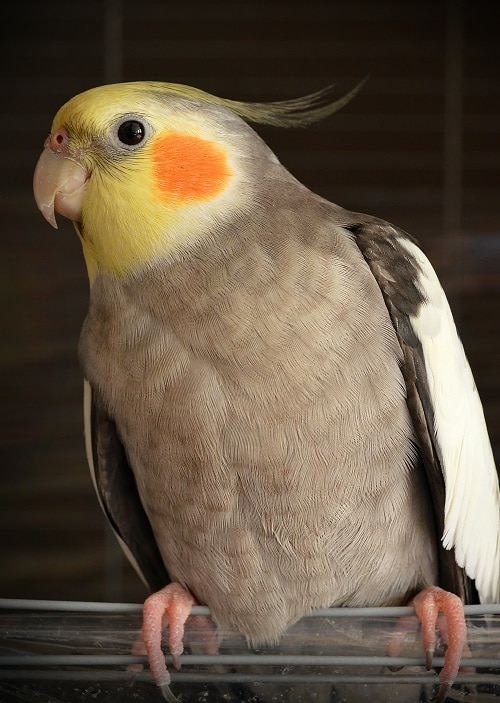
Caring for a cockatiel: Medical emergencies
Before we wrap up this guide to caring for a cockatiel, let’s go into one more very important, albeit less pleasant, aspect of cockatiel care.
As with any pet, it’s important to have a plan ready for medical emergencies. You should also be able to recognize basic symptoms of illness.
Tip: Adding a new cockatiel to your flock? You should always book a vet visit for general check-up. Better safe than sorry! An annual check-up is also not a bad idea.
Symptoms
It’s completely normal for a cockatiel to have a bad day once in a while. This especially applies when the bird is molting, when it might appear cranky and ‘off’ for a period of time. The occasional sneeze is also nothing to worry about, they’re pretty dusty creatures after all!
What you should definitely keep an eye out for is the following:
- Excessive resting or reduced responsiveness, with puffed feathers. Possibly on the bottom of the cage.
- Lack of interest in food.
- Persistent sneezing, especially if there’s discharge that’s not clear in color.
- Bleeding. This is very serious, as a bird can quickly bleed out.
- Wheezing.
- Abnormal looking poops. You should know what a healthy poop looks like!
- Tail bobbing.
- Vomiting. Yes, cockatiels can throw up!
Aside from these, just be sure to always keep a close eye on your bird. You know its normal behavioral patterns and how it looks. If that suddenly changes, a vet visit might be in order.
Emergency planning
Part of properly caring for a cockatiel is to be able to spring into action right away if something’s wrong with your feathered friend.
Make sure you’ve got the following in order:
- Have the numbers for 1-2 avian vets in your area on hand.
- Vet procedures are not cheap. Having an emergency fund can help soften the blow. I like having about €350 ready, which is $400-450.
- Have a little avian emergency kit stashed somewhere. Blood clotting powder, tweezers, gauze, disinfectant wipes, that sort of stuff.
- A travel cage or a spare shoe box can prove invaluable.
If you have any more questions about caring for a cockatiel or want to share your own experiences with these spunky parrots, don’t hesitate to leave a comment below! ?
Sources
Image sources
Cover photo © beeboys on Adobe Stock. Cockatiel with millet © KP on Adobe Stock. Cockatiel with coconut toy © Reimar on Adobe Stock.
